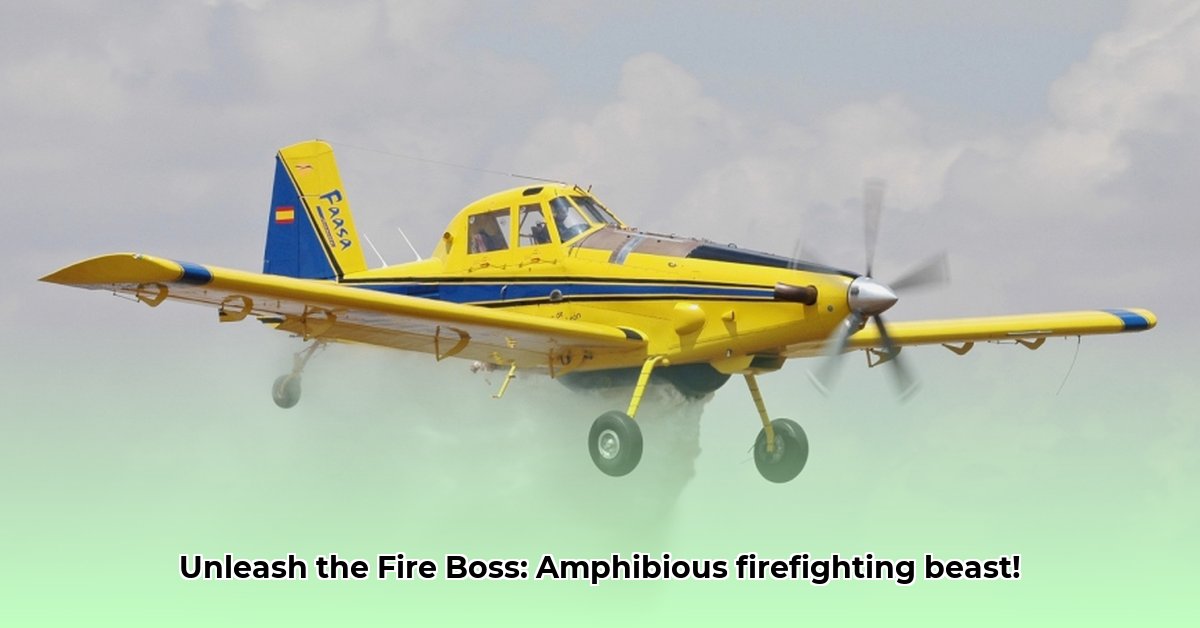
The Air Tractor AT-802F Fire Boss is a revolutionary amphibious aircraft, transforming aerial firefighting with its unique water-scooping capabilities and impressive performance. This article explores its design, operational considerations, market standing, and future potential within the increasingly critical field of wildfire suppression. For a smaller scale model, check out this Air Tractor model.
Performance and Capabilities: A Powerful Asset
The AT-802F is powered by a robust 1,600-horsepower engine, enabling a cruising speed of approximately 150 knots (173 mph). This speed, combined with its impressive 820 US gallon water/retardant capacity, allows for rapid response and significant fire suppression in single passes. Its defining feature, however, is its amphibious capability. This allows for direct water scooping, eliminating time-consuming ground refilling and significantly reducing response times – a critical advantage in rapidly spreading wildfires. How quickly can the Fire Boss reach a blaze and begin water drops? Its speed is a key factor in its effectiveness.
| Characteristic | Approximate Value | Impact |
|---|---|---|
| Maximum Takeoff Weight | Varies with payload | Influences maneuverability and speed. |
| Water/Retardant Capacity | 820 US Gallons | Significant payload for efficient fire suppression. |
| Cruise Speed | ~150 knots (173 mph) | Enables rapid deployment and transit between water sources and fires. |
| Rate of Climb | Varies with payload | Impacts operational flexibility and response speed in challenging terrain. |
| Stall Speed | Varies with payload | Crucial for safe operation, especially at low altitudes. |
These specifications are subject to variations based on factors such as altitude, temperature, and payload weight. Heavier loads naturally impact climb rate and range.
Operational Considerations: Distance to Water Sources
While the Fire Boss's speed and capacity are impressive, its operational efficiency is significantly impacted by the distance to water sources. Every minute spent traveling to refill reduces the time spent actively fighting the fire. This directly impacts overall effectiveness and increases operational costs per gallon of water or retardant. What strategies can maximize the Fire Boss’s efficiency in relation to this crucial factor? The answer involves careful planning and strategic deployment.
Market Implications: A Leader in Aerial Firefighting
With over 350 units in operation globally, the AT-802F has established a strong market position. However, the significant acquisition and maintenance costs present a barrier for smaller organizations. The Fire Boss competes with other aerial firefighting platforms, promoting ongoing innovation and a focus on cost-effectiveness within the industry. What is the key to continued market success for the AT-802F? Continuous innovation and improvements in efficiency and cost-effectiveness.
Technological Nuances: Advanced Features for Enhanced Performance
The AT-802F incorporates advanced technologies designed to improve both safety and efficiency. Automated foam systems and advanced engine monitoring are crucial examples. However, these sophisticated systems require specialized maintenance and highly trained personnel, contributing to the overall operational costs.
Conclusion: The Future of Amphibious Firefighting
The Air Tractor AT-802F Fire Boss represents a significant advancement in aerial firefighting, providing unparalleled speed, versatility, and response capabilities. Future development focuses on improving operational efficiency, especially concerning distance to water sources. Potential advancements include enhanced water-scooping technology, fuel-efficient engines, and streamlined maintenance procedures. The AT-802F will continue to play an essential role in protecting communities and natural resources from the devastating effects of wildfires.